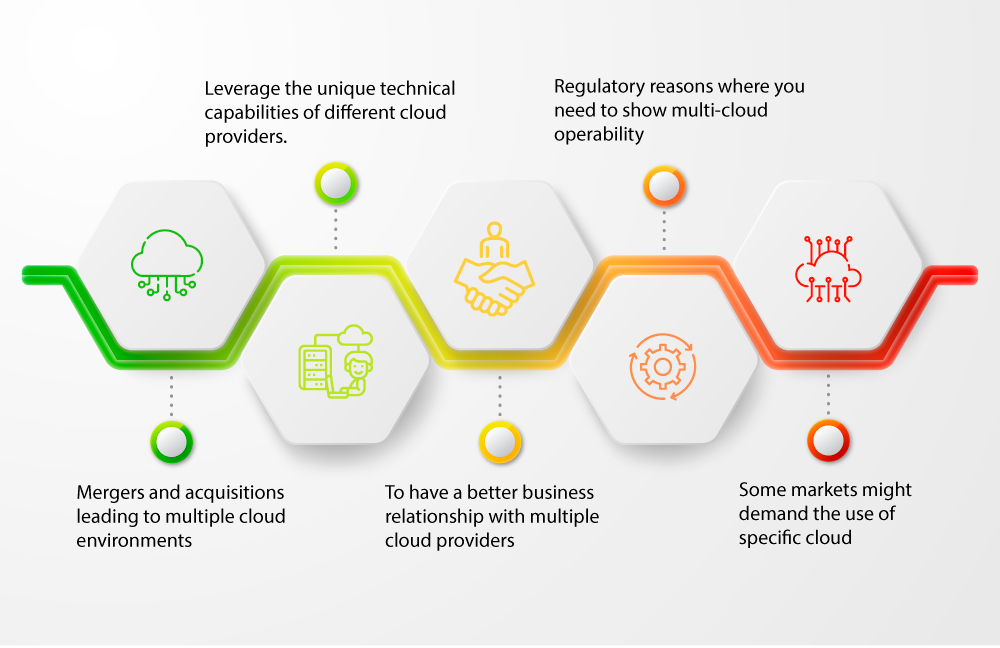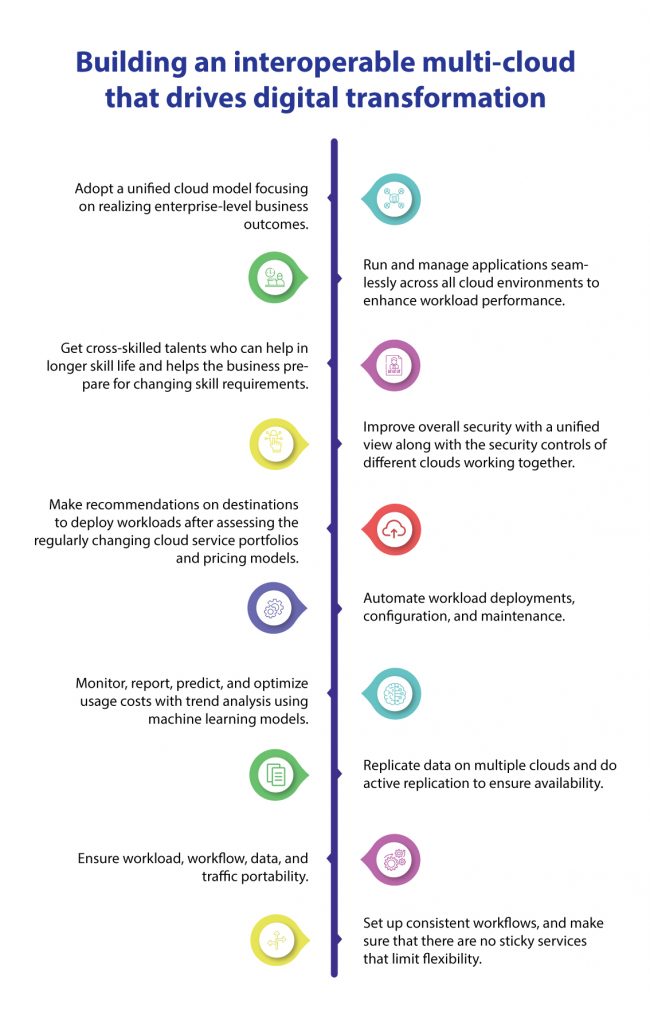
28 Jun Designing a multi-cloud strategy for digital transformation
Designing a multi-cloud strategy for digital transformation
Cloud is a major driving factor in enabling digital transformation as migrating to the cloud involves technical, operational, and cultural changes in an organization. Most organizations are already on the cloud or are thinking of adopting a cloud strategy. With so many cloud consulting service providers offering compelling and unique technology, how do you decide which one is right for you? Should you choose a cloud provider or go for a multi-cloud strategy to drive the digital transformation of your enterprise?
To start with, what is a multi-cloud?
Multi-cloud is a popular cloud implementation strategy consisting of two or more cloud platforms, public or private. It promises agility, interoperability, and flexibility between different cloud environments. The advancements in the field of containers and Kubernetes have helped in modernizing legacy applications and increased the popularity of multi-cloud strategies.
How does a multi-cloud differ from a hybrid cloud?
When you include bare metal infrastructure and one or more cloud platforms, it becomes a hybrid cloud. Hybrid cloud and multi-cloud are different and have different implementation strategies.
So, why do you need multi-cloud?
Consider that your enterprise needs advanced AI/ML capabilities of Google Cloud, 0365, or Azure Active Directory from Microsoft Azure and compute from AWS, and do not want to choose. You can have a multi-cloud strategy to get the best of all clouds. Another use case is when you have sensitive data that you can only use in a private cloud while you need the capabilities of a public cloud service.
There can be many reasons why you need a multi-cloud strategy such as,

Some enterprises might choose to be multi-cloud by design while others might be using multi-cloud by default. Either way, you need to be able to use and manage data and workflows in a multi-cloud environment efficiently.
What are the benefits of a multi cloud strategy?
Why do enterprises choose a multi-cloud strategy? Multi-cloud makes your environment complex, but it can add business value which makes it worth it. So, here are some benefits that you get from implementing a multi-cloud strategy.
No risk of relying on a single cloud provider
“Do not put all your eggs in the same basket”. The same goes for your workloads. IT outages can affect your credibility and revenue and availability is a major concern in the cloud. With multi-cloud, you can use replication of critical functionalities in a different cloud environment and failover in case of a disaster.
Accelerate digital transformation
Cloud helps businesses go from capital expenditure to operational expenditure and use the latest technological advancements to their benefit by providing them as a service. Many cloud providers are developing unique solutions to challenges in the cloud that you can access easily in a multi-cloud environment. A multi-cloud strategy can help you to fast-track your digital transformation journey.
Better workload performance
Different workloads are more suited to different clouds and can perform better there. If you design your multi-cloud with flexibility as a strategic consideration, you can increase the overall performance by deploying workloads where they can perform the best.
More negotiating power to you
Vendor lock-in is a major concern when choosing a single cloud provider. But, if you have the ability to move across cloud providers, you can leverage it to get better offers and discounts from your cloud providers without the risk of being tied up to one.
Scale as you grow
A large enterprise might be dealing with different mergers and acquisitions as they grow, and these companies have different cloud environments. In such a case, a well-defined multi-cloud strategy can help in integration and interoperability when needed.
Digital ecosystems are becoming increasingly complex and multi-cloud is at the center of it. Orchestrating and managing a multiple cloud environment requires planning and vision to accommodate growth. When using multi-cloud to drive digital transformation, having a unified view is important.
Key Principles for Multicloud adoption
Interoperable design
Interoperable design is important to ensure agility and a seamless flow of data and workloads across the environment. You need to plan for interoperability in the early stages of development and align your strategy with your vision, eliminate waste and avoid vendor lock-in.
To enable interoperability, you should design workloads with service-centric principles, utilize and expose APIs, write cloud-agnostic code, minimize the use of platform-specific tools and avoid hardcoding private information.

Multi cloud management and discovery platform
Service discovery, orchestration, and management of diverse cloud environments are some of the major challenges associated with multi-cloud. Cloud management and discovery platforms offer tools to manage app deployments and operations, data sets, and infrastructure and provide visibility across cloud environments. They provide access and authorization management, resource discovery, management across-the-board environment, financial management, service integration, and automation through a service catalog to support self-service provisioning and cloud brokerage. It can also help define governance and policies if you are a beginner.
Integration platform
Another major challenge in multi-cloud is to make data sources and apps deployed work together.
Traditionally we used to depend on point-to-point solutions to integrate specific app or platform endpoints and address complex integration requirements that exist within and among multiple clouds. But point to point solutions create highly complex environments, solutions that are difficult to scale, lack flexibility, and require a lot of maintenance. We need a comprehensive component-based integration platform that enables different cloud resources and multiple generations of technologies to work together. Reassess the approach in using integration platforms by taking factors of the technology landscape, past investments, talent, and cost and selecting a combination of technologies that simplifies the integration complexity.
Hyperscalars
Hyperscalars now offer platforms like Google Anthos and AWS ECS anywhere that work on other clouds and preconfigured hybrid cloud appliances. These promises simplicity of working in similar environments on both public and private clouds. But it is better to avoid using the multi-cloud with hyperscalars as they have pitfalls like vendor lock-in which is the same as the single cloud vendors and costs more in the long run.
Containerization
Multi-cloud should have portability and interoperability and allow enterprises to move workloads freely across cloud environments and even on-premises by enabling the virtualization of apps and dependencies. To achieve this flexibility, you need platform agnostic container solutions which adapt as you evolve. Using an open-source cloud framework provides enterprises the flexibility to work with any apps or infrastructure.
Open cloud standards
Standardization is the key to enabling interoperability in a multi-cloud environment. Using standard APIs, protocols, and data formats whenever possible and leveraging open APIs and protocols whenever possible can help to create vendor-agnostic interoperability.
.

Multi-cloud management
A multi-cloud environment is complex and managing and orchestrating workloads across different cloud environments is very difficult as every cloud has its own dashboards. This is why you need a multi-cloud management platform.
A cloud management platform is a single pane of glass to discover all of your workloads, provision and manage them, and better control overall cloud cost and performance.
You might need a consistent way to provision across multiple clouds or direct access to proprietary services in specific clouds and visibility to the level of consumption and cost. A cloud management platform can give you this unified view.
With a multi-cloud management platform, you can make use of self-service capabilities, automate your workflows and analyze and monitor the cloud environment.
A combination of cloud management and security platform allows you to treat all your cloud as a single virtual cloud and you can decide what IT services should you deliver with your single virtual cloud.
3 Key considerations when adopting a cloud management platform for your multi-cloud strategy
Automation
With multiple cloud environments having different configurations, authentication and processes, it can be difficult to manage the development and operations if you do not have a unified dashboard to discover the services and configurations that you need. To improve performance and agility, automate everything you can. For example, you need to deploy a new app, a docker container to two cloud environments. It would be difficult to do it in the traditional CI/CD and DevOps workflows. You can use the control plane to spin up containers in both clouds with a single command.
Visibility and performance monitoring
Visibility is very important in multi-cloud environments as each cloud has its own dashboards, and the need to have a single unified way of managing those is important.
For an operations engineer, a single control dashboard is important as it provides a unified way to view the clusters they have spun up and go down deeper if required and see something like deployments in applications across multiple clouds.
Governance and security
Regulatory and compliance policies are different across different geographical regions and are becoming increasingly strict. If you have a policy that they want to push out across all the clouds, it would be a painstaking and time-consuming effort if you do not have a control pane. Take advantage of the control plane and push compliance policy across multiple clusters with a single command and ensure the security policies for compliance are being met.
Cloud Management Platforms (CMPS) to consider for your multi-cloud strategy
There are many cloud management platforms, but you need to choose one that is right for your business priorities. Let us take a look at some cloud management platforms that you can consider for your multi-cloud strategy.
Embiotics
This cloud management platform called Snow commander is known for the visibility of public, private, hybrid, and multi-clouds.
Pros
- Fast installation and low-cost setup
- Easy and automated report generation
- Automated provisioning and decommissioning
- Customizable multi-cloud service catalogue
- On-demand user portal
Cons
- Complicated UI/UX
- Technical knowledge required
Appito Cloudability
This cloud management platform helps you manage costs in multi-cloud operations.
Pros
- Automatically download and aggregate data from public cloud environments to provide standardized cost.
- Tracks spending across application, projects and business units and usage reports
- Provide unified reports from multiple vendors in standard form
Cons
- Only address cost management
Morpheus
It offers an automated and orchestrated framework for managing cloud environments and is application centric.
- Self service provisioning with a single click
- Codeless integration
- Persona based data management
- Operation and automation with different cloud services
- Codeless integration and SDK plug-ins for creating integrations
Cons
- Very steep learning curve and not enough training materials
- Complex UI
- No free trial and costly
Flexera
Flexera was known as RightScale and is a good cloud orchestration and management platform.
Pros
- Simplified platform
- Orchestrates and automates services
- Effortlessly integrate with top configuration tools
- Automated backups and failovers for disaster recovery
- Built-in support for networking and orchestrates the APIs
- Alerts about unused cloud resources
Cons
- Delays in deployment
- Steep learning curve
- Pricing and cost ratio
In Conclusion
Why do you want to use multi-cloud? How can a multi-cloud approach help me in scaling my IT environment and services? It is very important to ask yourself these questions before opting for a multi-cloud approach. Multicloud is a means to digital transformation and not an end. The cloud environments are rapidly evolving with new features and services. You need to build a solid business case and find an experienced partner to help you in the journey. It is important to understand the challenges of multi-cloud and its limitations to effectively use multi-cloud to get what it promises. When designing a multi-cloud strategy, use creative solutions and established design principles to overcome them. Design your multi-cloud strategy to increase productivity, performance, cost efficiency and flexibility with the right Cloud migration consultants.
